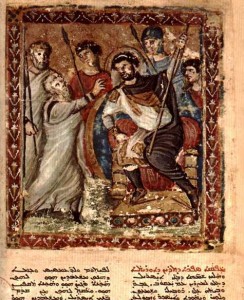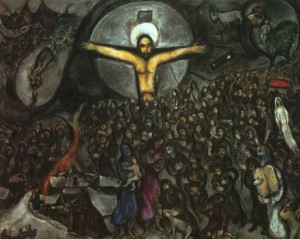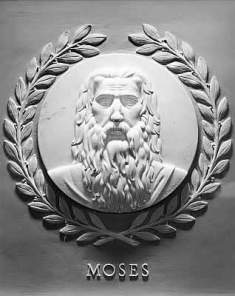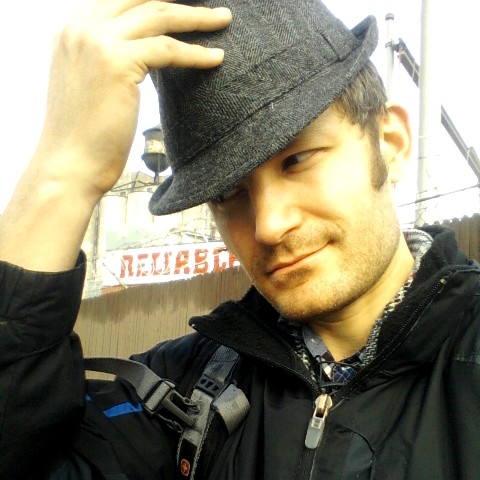The End of Moses and the Beginning of the Year – Part 2
12 Oct 2011 Leave a Comment
in Bible, Jewish praxis, Theology
Around two weeks ago, I posted the first part of this series exploring the connections between the last narrative section of the fifth book of the Bible and the Jewish high holiday, Rosh Hashannah. Since the article I posted before this was also on the long side and dealt with some heavy topics, I broke things up a bit in my last post by delving into an exploration of the concept of lived simplicity. Although we have now passed the time in the Jewish calendar devoted to Rosh Hashanah, there is still quite a bit I would like to share by developing the preliminary work I did two weeks ago. So, this post will pick up where we left off back then in order to dig into the meat of Deuteronomy 29:9 – 31:30, showing how this portion of scripture so beautifully lays out key aspects of one of the most important biblical holidays, which is traditionally celebrated by Jews right around the same time each year that many of them are meditating on this portion of scripture.
My goal in the previous part of this series was to prepare the grounds for this process by highlighting various aspects of Jewish life and practice that are intimately tied to both the text and the holiday in question. My hope is to facilitate a robust engagement with the cultural context in which this portion of holy scripture is frequently read by the religious community that received it, which will in turn enable us to engage with God in a unique and vital manner often neglected in the church. Among other things, I mentioned how the Jewish rabbis partitioned the Torah, the first five books of the Bible, into sections called parshas that one can study sequentially each week over the course of a year. In fact, if you ever visit a synagogue to participate in a service of worship on Shabbat (more popularly known in English as “the Sabbath,” the seventh day of the week), you will probably hear a message delivered by the presiding rabbi that analyzes the parsha for the week. The parsha for the week during which Rosh Hashanah occurs is our text, Deuteronomy 29:9 – 31:30.
Last time, I also discussed how the Jewish calendar works quite a bit differently than the Gregorian or Julian calendar. It marks its first year from the date the rabbis calculated back to the creation of humanity such that we are presently living in year 2011 C.E. according to the Julian and Gregorian calendars and year 5772 according to the Jewish calendar. Also, there are not one but four different points marking the beginning of the year for the Jewish calendar, Rosh Hashanah being one such point commemorating the new year from a perspective celebrating the creation of the world and ramping up over ten days to Yom Kippur, the holiday commemorating God’s process of atoning for the sins of the Jewish people and thereby reconciling them back again to a restored, righteous relationship with God.
This time around, I will pivot from describing the praxis of the celebration of Rosh Hashanah and the reading of Deuteronomy 29:9 – 31:30 in the Jewish community today to laying out the biblical context of the text in question. I want to plow into this parsha to answer four different yet interrelated questions: 1) Just what is going on in this text in general, 2) how does it relate to the holiday of Rosh Hashanah during which it is traditionally read, 3) what on earth does this tell us about who God is, and 4) what might be our response–how does all this not only serve to inform us but to transform us? So, by the end of this post, we should have acquired both the cultural context in which our text is read by the Jewish community as well as the biblical context in which the text can be found. That will enable us to do the in-depth, exeggetical drilling in the final post of this series to take a solid crack at answering those four questions I mentioned above.
Incidentally, I’m writing this post while rocking out to this song, which you should clearly listen to right now while you’re reading this to capture the synergistically epic nature of the compositional moment. Or maybe this one if you want to swing in a more Jewish direction or something…
Okay, Deuteronomy received its English title from the Greek term, “Deuteronomion,” which means “second law.” This refers to the recapitulation of much of the teaching delivered over the previous three books of Torah–Exodus, Leviticus, and Numbers. These books tell the story of God’s deliverance of the Jewish people from slavery in Egypt through Moses, one of the single most important prophets and leaders mentioned in the entire Bible. According to Exodus 33:12 34:35, Moses is the only individual mentioned in the entire first half of the Bible who gets a glimpse of God’s glorified presence; in fact, Moses’ countenance became so radiant from this encounter that he terrified other people who saw him afterwards such that he walked around with a veil over his face to keep them from flipping out. Numbers 12:3 describes Moses as being “more humble than anyone else on the face of the earth,” and yet God worked so powerfully through him that the Lord himself said that he had made Moses “like a god” to others with whom he came into conflict, such as the king of Egypt in Exodus 7. In fact, Exodus 34:10 says that God spoke with Moses “face to face,” and Numbers 12:8 says that Moses spoke with God “mouth to mouth,” which are parallel literary devices indicating a degree of intimacy in communication greater than virtually anyone else in the entire Bible. (Remember, not even Moses could handle actually looking directly at God face to face according to Exodus 33:12 and following.)
Given all of the above, it is little wonder why the final redaction of Deuteronomy 34:10 indicates that no other prophet had arisen in Israel like Moses ever since, a person whom “the LORD knew face to face.” Now, all those capital letters that get brought into most English translations with this verse indicate the most holy iteration of the name of God in the Old Testatment, nicknamed “the Tetragrammaton,” which means “the four letters.” Why such a strange moniker? Because the Hebrew text doesn’t actually spell out the entire name of God in this case; it was thought to be too holy to even write out in this form. Instead, there are just four Hebrew letters present in the text–yodh, he, waw, and he–and the rabbis actually mixed in some different vowel markings over time to prompt any reader following along to use a completely different word at this point when reciting scripture aloud out of reverence, namely the word, “adonai,” which is the Hebrew term for “lord” or “master.” In other words, Deuteronomy 34:10 is juxtaposing the single most holy name of God with the statement that God knew Moses “face to face.” That’s as freaking intimate as it gets all the way until Messiah Jesus, the Son of God, shows up in the New Testament. This is probably why John 1:17-19 purposefully states that “the Son” is “himself God,” that he is in closest relationship with God, that he is the only one to have truly “seen” God, and that he has on this basis “made God known” to those who follow him.
To continue with Moses, it is little wonder why the rabbis concluded that the person he identifies in Deuteronomy 18:15-19 as being one whom God would raise up as a prophet “like me from among you, from your fellow Israelites” must undoubtedly refer to the Messiah, the chosen and anointed one of God. (Of course, most rabbis do not conclude that this Messiah is Jesus, but that’s a topic for another time.) It is also little wonder why Moses shows up not once but twice in the closest thing we have to a comprehensive statement of faith for the Jewish community today, Rabbi Moses ben Maimon’s “13 Principles of Faith.” And that is also why it must have been utterly terrifying for the myriad Jewish people who had followed Moses for decades through the wilderness towards the Promised Land around the present-day State of Israel to even think of moving forward without Moses’ leadership.
But the twentieth chapter of the book of Numbers indicates that Moses would not survive the Jewish people’s journey from slavery to wilderness to homeland. In fact, almost nobody who had initially been delivered from slavery in Egypt survived that journey, and that is why the final book of Torah, the fifth book of the Bible, gets that nickname Deuteronomy, “second law,” because it was Moses’ last chance to reiterate in detail precisely what God had done on behalf of the Jewish people and what the terms of God’s covenant relationship with them was. That way, all the children of those who had directly witnessed God’s miraculous deliverance back in Egypt, those children who had quite literally grown up wandering around in the middle of nowhere between bondage and promise, would never forget who God is and what God had done–even if their parents’ had not related the story so accurately up to that point.
To really bring this point home, Moses not only reiterates the gist of the teaching recorded in the previous three books of the Bible across the text of Deuteronomy, he also boils all of it down into what is the closest thing to a central confession of faith for the Jewish people, the Shema. This is recited at every single Shabbat service of worship, and it’s the very same portion of scripture that Jesus himself quoted when asked what the greatest commandment in all of the first five books of the Bible could be. It’s right there in Deuteronomy 6:4-5, “Hear, O Israel: The LORD our God, the LORD is one. Love the LORD your God with all your heart and with all your soul and with all your strength.” It turns out that this is not just important for Jewish people in general, it’s rather important for the analysis of our parsha; so, let’s take a closer look.
Well, you can see a whole bunch of instances of that exceptionally holy name of God, the Tetragrammaton, in those two verses comprising the Shema. But you can also see several other things when you look into the Hebrew; for the sake of brevity, I’ll mention just a few:
- All of the Jewish people present are implored to “hear.” This isn’t a mere dictation but an attempt to draw into relationship even while informing and exhorting.
- The LORD–the most holy and awesome being in existence–is also the God of the Israelites. God is both transcendent yet also immanent. As Isaiah 57:10 later puts it, “For this is what the high and exalted One says—he who lives forever, whose name is holy: ‘I live in a high and holy place, but also with the one who is contrite and lowly in spirit, to revive the spirit of the lowly and to revive the heart of the contrite.'”
- “The LORD is one,” which means two things at the same time in Hebrew: First, that there’s just one, true God; God doesn’t need to jockey for power among some pantheon like the Egyptian, Sumerian, or Greek concepts of divinity. Second, that this God alone is the God of Israel–a sort of radicalization of the whole transcendence / immanence thing that illustrates the completely different sort of relationship God wanted to share with the Jewish people compared to how others understood their relationship with the divine was supposed to work.
- The bottom line of what God wants, what God commands, is love expressed through every aspect of one’s being. In an ancient, Jewish worldview, the heart (H. lebab) was understood to be the seat of the intellect, emotions, will, and appetites. The soul (H. nephesh) was understood to be the central essence of a person, the very life of a given being. So what base is left to cover in the appeal to love? Nothing! the final phrase that get’s translated into English as “all your strength” is literally something like “exceedingly much” or “abundant muchness” (H. m’od). It’s like God is imploring the Israelites, “I want you to love me with literally everything inside of you–your reason, your feelings, your volition, your passions, your very spiritual essence, your–well, you get the picture–your everything I put inside of you! Because that’s how much I love you.”
That’s why the Shema stands as a summary statement for the entire Torah, because all the rest of the stories and prophecies and commandments hang upon the truth expressed in these two, short verses. And there are repercussions for committing oneself to living accordingly on the one hand or else abandoning such a love-drenched relationship with God on the other hand. Living in the former way guides us towards the sorts of activities that bring wholeness and justice and truth to ourselves and those around us with prosperity being the result; living in the latter way not only severs our covenant relationship with God, it puts us at enmity with one another, too. The consequences of eschewing this love of God, of rejecting the activities predicated on a response to that love, is nothing short of destruction and death; the consequences of turning to God are overflowing life and peace. To make sure the Israelites would never forget this point, Moses separates all of the people into two groups located on two adjacent mountains in Deuteronomy 27 – 28, and they literally shout the blessings that would follow from their obedience to God’s commands from one mountain as well as shout the curses that would follow from their disobedience of God’s commands on the other mountain.
This brings us right up to Deuteronomy 29, the chapter where our parsha starts. If we were to look at what follows immediately after our parsha to round out our understanding of its biblical context, we wind up in a huge chunk of poetry that runs for a solid two chapters–the longest piece of prophecy that Moses delivers in the entire Bible. This is followed by a short, narrative epilogue describing his final resting place somewhere “in Moab, in the valley opposite Beth Peor,” a place that remains shrouded in mystery to this day. Deuteronomy 34:7 tells us that “Moses was a hundred and twenty years old when he died, yet his eyes were not weak nor his strength gone.” Well, dropping a couple chapters of prophetic poetry right before one hikes across a mountain and a valley before giving up the ghost certainly demonstrates that!
Now, ancient Hebrew lacks punctuation. So if one wanted to break up a section of narrative, one would typcially insert a section of poetry. And that’s exactly what the portion of scripture following our parsha is doing; it’s communicating through a Hebrew literary device that this is the end of this part of the story. But that means that our parsha is the very last chunk of substantial narrative in the entire Torah, the last bit of story before Moses delivers the longest and probably the most important monologue of his entire life. This means that whatever happens in our parsha must be incredibly significant. And every year, Jews read about the content of the end of Moses’ life at the exact same time that they are celebrating one of the most important holidays, Rosh Hashanah, the biblically mandated celebration that wound up getting associated with the beginning of the year from the perspective of the creation of the world. Why?
Now that we have explored both the cultural and biblical context of Deuteronomy 29:9 – 31:30 over the first two parts of this series, we can turn towards an in-depth analysis of the text itself to try to answer that question. And also the other three questions I mentioned above. Next time…










